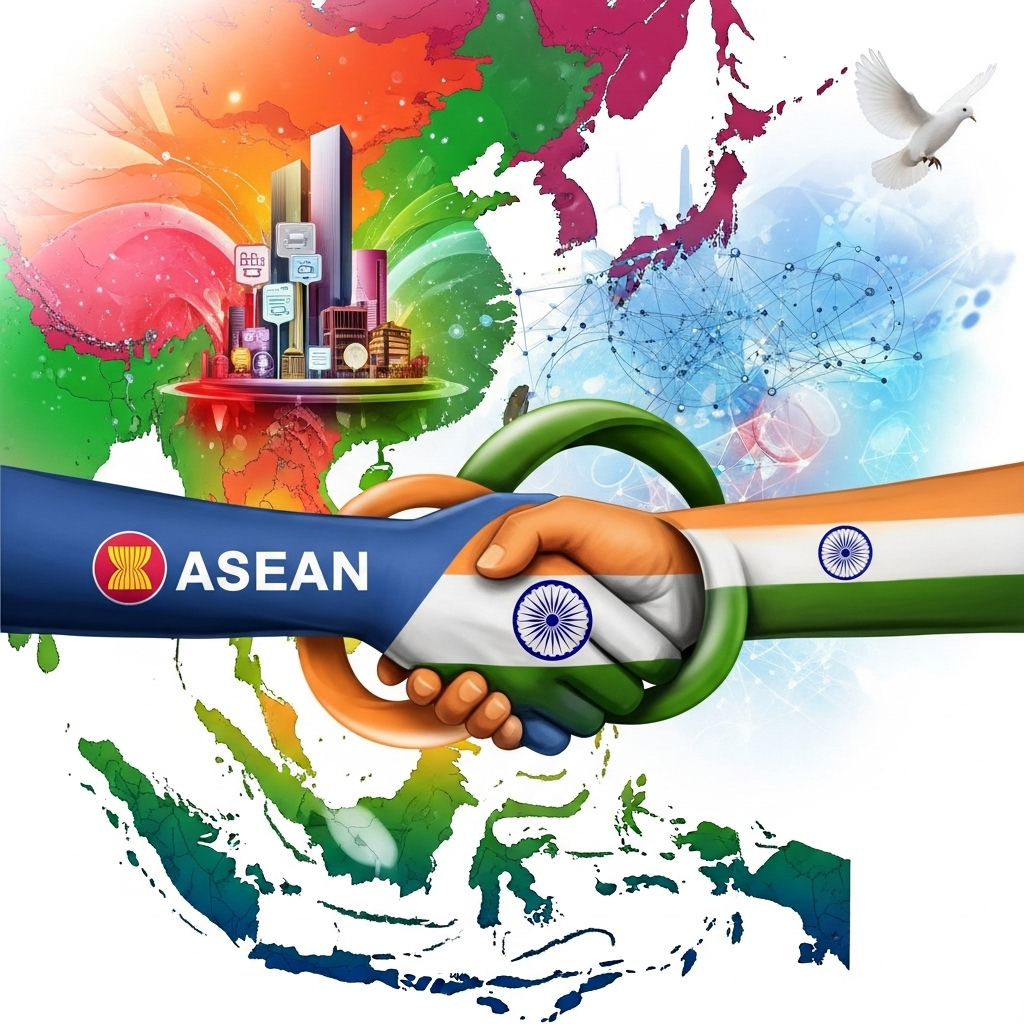
- The ASEAN bloc is an excellent example of regional integration in the contemporary world and has been of intrinsic value in the economic integration of the Southeast Asian region.
- On the 8th of August, 1967, Indonesia, Malaysia, the Philippines, Singapore and Thailand laid the foundation of the Association of Southeast Asian Nations, famously known as ASEAN, by signing the ASEAN Declaration together in Bangkok, Thailand.
- At present, major economies of Asia like India, China, Japan, South Korea and Australia have established Free Trade Agreements with ASEAN.
- Over the past three decades, India has managed to occupy important positions within ASEAN, such as sectoral dialogue partner, dialogue partner, summit level partner, strategic partner and a comprehensive strategic partner.
In 2024, ASEAN, as a regional grouping, completed fifty-seven years of its existence. The ASEAN bloc is an excellent example of regional integration in the contemporary world and has been of intrinsic value in the economic integration of the Southeast Asian region. It is not only a well-functioning multilateral organisation but has also managed to establish itself as a community. It has strongly contributed to bringing stability, security and peace in the Southeast Asian neighbourhood in general and to the Asia-Pacific region at large. Kishore Mahbubani, a famous Singaporean diplomat, in his book “ASEAN Miracle: Catalyst for Peace”, states that in the tumultuous world, Southeast Asia has achieved a very high degree of peace and stability. Scholars give much of the credit for the sped-up growth of Southeast Asia to ASEAN.
On the 8th of August, 1967, Indonesia, Malaysia, the Philippines, Singapore and Thailand laid the foundation of the Association of Southeast Asian Nations, famously known as ASEAN, by signing the ASEAN Declaration together in Bangkok, Thailand. The declaration proclaimed ASEAN as representing “the collective will of the nations of Southeast Asia to bind themselves together in friendship and cooperation and, through joint efforts and sacrifices, secure for their people and posterity the blessings of peace, freedom and prosperity.”1[1] The motive behind setting up this intergovernmental organisation was for the countries in the region to collaborate on the economic, social and cultural front. The ASEAN nations also expressed their will to collectively work towards the stability and regional peace, as well as towards development in educational, technical and other important fields.
Over the years, ASEAN was joined by Brunei Darussalam in January 1984, by Vietnam in July 1995, by Lao PDR and Myanmar in July 1997 and lastly by Cambodia in April 1999. Together they form the ten member states of one of the most successful regional organisations of the world today. The total population of the ASEAN countries in 2021 amounted to approximately 666.19 million inhabitants.2[2] The organisation also has an estimated combined gross domestic product (GDP) of 3.36 trillion U.S. dollars, thus highlighting a remarkable increase over the years.3[3] At present, major economies of Asia like India, China, Japan, South Korea and Australia have established Free Trade Agreements with ASEAN.
Another highly valued principle amongst the member nations of ASEAN is that of ‘non-interference’ in the internal affairs of one another. This has its source in the ‘Treaty of Amity and Cooperation’ signed by the members of Southeast Asia in 1976, which emphasises mutual respect and non-interference. It has also, time and again, collaborated with countries from regions all across the globe. However, even the most successful organisations are bound to have certain limitations. Scholars have noted weak leadership and differing priorities among the members of ASEAN. The ASEAN countries’ inability to develop a unified approach on certain issues has rather led to a diverging and diminished vision at times. Not only is the grouping subject to internal disturbances and limitations, but external factors like the rise of Chinese presence and wars in the South China Se, a too have also caused a huge level of disruption in the region.
Despite differences between some of its member states, ASEAN has managed to become the most successful regional organisation after the EU. At present, ASEAN is the most reliable platform for geo-political engagement in the Asia-Pacific region. Its member states agree that any sort of disagreement amongst them must be resolved in a peaceful manner and accordance with international law. R. Ravindran comments:
“In my view, ASEAN remains strong. It has always faced problems and challenges from day one, that is, from 1967 till the present day. It has gone through many crises which have been sorted out”.[4]
The exemplary regional cooperation shown by ASEAN is a source of inspiration for other developing regions such as the Gulf and South and Central Asia. The ASEAN nations are in an exploratory phase and rediscovering avenues for further growth and development. In the present global order, ASEAN is considering looking beyond the Asian superpowers to maximise the organisation’s economic growth. The organisation has been consistently expanding and has several dialogue partners and summit-level partners. The ASEAN+3+3 include Japan, China, South Korea, as well as Australia, New Zealand and India.
India’s association with ASEAN
Since its foundation, there have been a number of occasions that have led to ASEAN and India coming together. The last decade of the 20th century marked the beginning of India-ASEAN relations when, in the year 1992, India became its sectoral dialogue partner and later in 1995 became its full dialogue partner. This was quite a milestone achievement for both. In the year 2002, the first-ever ASEAN-India Summit took place in Cambodia and has been regularly held since then. Their partnership was further elevated to the level of a Strategic Partnership at the ASEAN-India Commemorative Summit, which was held in New Delhi in 2012. The two sides also celebrated the completion of their twenty-five years of partnership in 2017. Such initiatives and collaborations have further resulted in the comprehensive development of the India-ASEAN relationship.
Increased visits from both sides over the years have reflected and strengthened political relations between the two regions. Over the years, India-ASEAN interactive engagements have also qualitatively enhanced resulting in meetings at all levels such as summits, ministerial, senior officials, and experts, as well through dialogue and cooperation framework by ASEAN such as the ASEAN Regional Forum (ARF), the Post Ministerial Conference (PMC) 10+1, the East Asia Summit (EAS), and the ASEAN Defence Ministerial Meeting Plus (ADMM Plus).[5] These are some of the multilateral initiatives led by ASEAN in which India participates and plays a key role.
India also became an active member of several multilateral regional organisations, such as the Mekong-Ganga Cooperation (MGC) and the BIMSTEC. Furthermore, in order to economically upgrade the India-ASEAN partnership and yield mutual benefits, India signed a Free Trade Agreement with members of ASEAN countries in the year 2009. The trade and investment between the two sides has been growing steadily since then. It is primarily the political will of leaders on both sides that has given way to such an economic flourishing of the India-Southeast Asia ties. The ASEAN countries, too, needed to collaborate with India because only with their participation and support of strong stakeholders can they help in bringing peace and prosperity to the Southeast Asian region, as well as to the Asia-Pacific region as a whole.[6]

Despite a mutual will to collaborate, there have been certain differences between India and ASEAN which hampered the smooth functioning of their relationship. India was not invited for ASEAN membership when it was formed in 1967. India’s domestic challenges, such as border wars with Pakistan and China and its struggling and closed economy, posed a concern for ASEAN states and became a roadblock in its initial economic partnership with Indonesia, Malaysia, the Philippines and Thailand.[7] At the same time, during the initial years of ASEAN’s formation, India was rooting for a larger regional bloc in Asia and had its reservations about ASEAN. India began to express its support for ASEAN more explicitly starting in 1973. Another obstacle in smooth India-ASEAN relations was the Kampuchean issue, where India decided to recognise the Republic of Kampuchea in 1980, which did not sit well with most ASEAN members.[8]
However, since the inception of the earlier Look East Policy and now the revamped Act East Policy, India-ASEAN relations have witnessed remarkable advances in their relations. Over the past three decades, India has managed to occupy important positions with ASEAN, such as sectoral dialogue partner, dialogue partner, summit level partner, strategic partner and a comprehensive strategic partner.[9] To mark the 30th anniversary of ASEAN-India relations, both sides elevated their partnership to the level of a Comprehensive Strategic Partnership in November 2022. This Comprehensive Strategic Partnership, according to scholar, is an important milestone in ASEAN-India ties as it allows the two sides to realign their relations and work together towards common interests.[10] The five focus areas for Indo-ASEAN cooperation specified under the Partnership are: maritime security, cyber security, joint implementation of projects in the Indo-Pacific, joint operability of digital financial systems and new technologies for sustainable development.
References:
- [1] Association of Southeast Asian Nations (ASEAN). “About ASEAN.” ASEAN. Accessed July 25, 2025. https://asean.org/about-us/.
- [2] Neill, O. Aaron, “Total Population of ASEAN Countries from 2018 to 2028,” International, Statista, November 30, 2023.
- [3] Neill ’O, Aaron. 2023. “Gross Domestic Product of the ASEAN Countries from 2018 to 2028.” International, November 30, 2023. Statista.
- [4] R. Ravindran. ‘India and ASEAN’. Delhi-Dialogue VIII: ASEAN-India Relations: A New Paradigm. IDSA. Pentagon Press. 2018.
- [5] Kaul, Man Mohini, “Reflections on India’s Relations with ASEAN: From Look East Policy to the Act East Policy” in Connecting Nations: Politico-Cultural Mapping of India and Southeast Asia, edited by Achintya Kumar Dutta, Anasua Basu Ray Chaudhury, New Delhi, Primus Books, 2019.
- [6] R. Ravindran. ‘India and ASEAN’. Delhi-Dialogue VIII: ASEAN-India Relations: A New Paradigm. IDSA. Pentagon Press. 2018.
- [7] Kaul, Man Mohini, “Reflections on India’s Relations with ASEAN: From Look East Policy to the Act East Policy” in Connecting Nations: Politico-Cultural Mapping of India and Southeast Asia, edited by Achintya Kumar Dutta, Anasua Basu Ray Chaudhury, New Delhi, Primus Books, 2019.
- [8] Muni, S. D., Mishra, Rahul. India’s Eastward Engagement: From Antiquity to Act East Policy. Sage Publications. 2017
- [9] Marjani, Niranjan, “30 Years of Asean-India Relations: Advances and Challenges”, Centre for East Asian Studies. February 2023.
- [10] Ibid
Faareha is a final-year Ph.D. scholar researching India’s Act East Policy, with a keen interest in the Indo-Pacific region and India’s maritime relations with its neighbours. She has previously interned at the Indian Council of World Affairs, a think tank under the MEA, and has worked as a Subject Matter Expert and Script Writer in Social Sciences.
